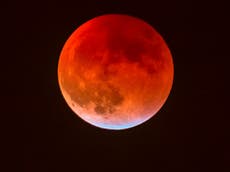Blood super moon May 2021: What is rare lunar spectacle and when will it appear?
Nasa explains why the next full moon will have a ‘deep, rosy glow’

Your support helps us to tell the story
From reproductive rights to climate change to Big Tech, The Independent is on the ground when the story is developing. Whether it's investigating the financials of Elon Musk's pro-Trump PAC or producing our latest documentary, 'The A Word', which shines a light on the American women fighting for reproductive rights, we know how important it is to parse out the facts from the messaging.
At such a critical moment in US history, we need reporters on the ground. Your donation allows us to keep sending journalists to speak to both sides of the story.
The Independent is trusted by Americans across the entire political spectrum. And unlike many other quality news outlets, we choose not to lock Americans out of our reporting and analysis with paywalls. We believe quality journalism should be available to everyone, paid for by those who can afford it.
Your support makes all the difference.The full moon in May will coincide with two rare events that will make it appear bigger, brighter, and – in some places – redder.
The celestial coincidence has earned this month’s full moon the moniker ‘Blood supermoon’, and it will be the first one since 2019.
It is one of only two supermoons in 2021, which take place when the moon is at or near its closest point to Earth. The previous one in April not being quite as close, meaning this month’s will be the biggest and brightest of the year.
Nasa has described it as the “most super” of this year’s moons, and it is set to appear on 26 May – though it will appear full in the sky to the casual observer for a day either side.
Across large parts of the Americas and Australasia, a total lunar eclipse will also occur on 26 May, which is what gives it the ‘Blood’ name.
“A lunar eclipse takes place when the Sun and Moon occupy precise positions on opposite sides of Earth,” Nasa’s website explains.
“During this alignment, Earth blocks some of the Sun’s light from reaching the full moon. Our atmosphere filters the light as it passes, softening the edge of our planet’s shadow and giving the Moon a deep, rosy glow.”

A partial lunar eclipse will also be visible in large parts of Asia, including India, Nepal, western China, Mongolia and eastern Russia.
Unlike the lunar eclipse, the supermoon will be visible all over the world, rising in the east at around sunset and setting in the west at around sunrise.
Due to an optical trick known as the Moon Illusion, the supermoon will appear even bigger and brighter to sky gazers when it is close to the horizon. One explanation for this is that its relative size to objects on the horizon make it seem like it is bigger than it actually is.
Weather forecasts in the UK suggest favourable conditions will make it a great opportunity to view the supermoon next week.
Long range forecasts from the Met Office suggest the start of the week will be unsettled but that it will clear up as the week progresses.



Join our commenting forum
Join thought-provoking conversations, follow other Independent readers and see their replies
Comments